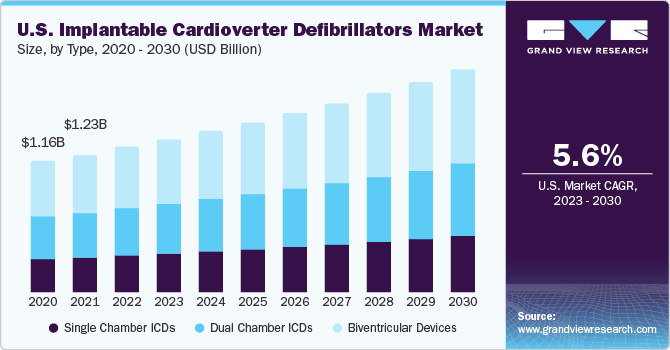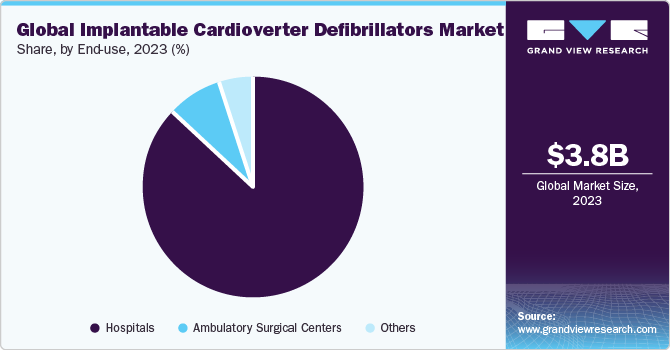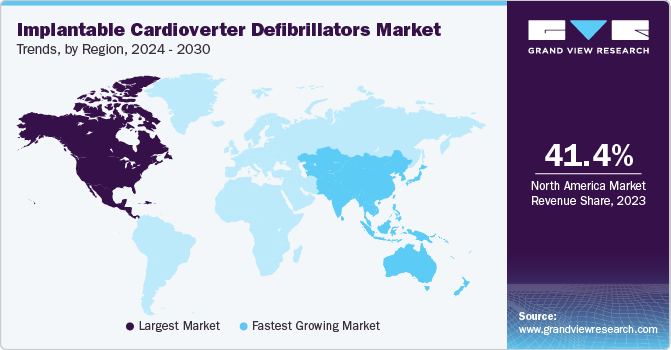- Home
- »
- Medical Devices
- »
-
Implantable Cardioverter Defibrillators Market Report, 2030GVR Report cover
![Implantable Cardioverter Defibrillators Market Size, Share & Trends Report]()
Implantable Cardioverter Defibrillators Market Size, Share & Trends Analysis Report By NYHA Class (NYHA Class I, NYHA Class II), By End-use (Hospitals, Ambulatory Surgical Centers), By Product Type, By Type, By Region, And Segment Forecasts, 2024 - 2030
- Report ID: GVR-4-68040-109-4
- Number of Report Pages: 174
- Format: PDF, Horizon Databook
- Historical Range: 2018 - 2022
- Forecast Period: 2024 - 2030
- Industry: Healthcare
Market Size & Trends
The global implantable cardioverter defibrillators market size was estimated at USD 3.81 billion in 2023 and is projected to grow at a CAGR of 6.4% from 2024 to 2030. The implantable cardioverter defibrillator (ICD) is an electronic medical device used to monitor and regulate heart rhythms in individuals at risk of life-threatening arrhythmias like ventricular tachycardia (VT) and ventricular fibrillation (VF). Factors driving the market growth include technological advancements, increasing incidence of sudden cardiac arrest, growing public awareness, and supportive policies by governments and healthcare organizations. The market also benefits from the innovation efforts of emerging players for instance, in July 2022, MicroPort Scientific Corporation received a CE mark for its INVICTA line of defibrillation leads. With the rising prevalence of cardiovascular diseases (CVDs), the demand for advanced cardiac care solutions, including ICDs, is expected to grow, offering opportunities for expansion and advancements in the healthcare sector.

The COVID-19 pandemic had a negative impact on the market. During the first quarter of 2020, various countries, such as the U.S., halted different forms of elective surgeries and the use of beds to cater to COVID-19 patients. In addition, various supply chain disruptions were witnessed across regions. For instance, in 2020, MicroPort Scientific Corporation reported a decrease in revenue by 18.24% compared to 2019. Similar trends were recorded by other players in the market. During the pandemic, companies and governments implemented various corrective measures, including policy and monetary stimulus, easing of restrictions, and strategic initiatives to support economies and businesses. Abbott's launch of COVID-19 tests enabled the company to navigate the challenging business environment and offset revenue losses in segments like cardiovascular management. Telehealth gained significant traction, particularly in cardiology, to remotely monitor and manage patients with arrhythmias, reducing exposure risks.
The demand for Cardiac Resynchronization Therapy Devices (CRT-Ds) is expected to rise due to the increasing prevalence of cardiac disorders and associated risk factors, making Sudden Cardiac Arrest (SCA) deaths a significant cause of mortality. Heart failure, a leading cause of death globally, further contributes to the need for CRT-Ds. The rising prevalence of SCA has led to a growing demand for defibrillators, as survival rates remain low, especially in out-of-hospital cases. ICDs are essential for patients with abnormal heart rhythms, with a higher prevalence among older adults, particularly those with coronary artery disease (CAD).
Market Dynamics
Technological advancements and product innovations, such as Medtronic's Epsila EV MRI SureScan and Aurora Extravascular (EV)-ICD MRI SureScan, present promising solutions with reduced complications and enhanced placement techniques. The continual progress in technology, particularly the notable success rates observed in recent years for ICDs, is anticipated to drive further expansion in the market. For instance, in August 2022, Medtronic PLC presented clinical research showcasing the efficacy of an innovative minimally invasive defibrillator implant, the Medtronic EV ICD system, designed to prevent sudden cardiac arrest. This extravascular implantable defibrillator system, with its primary component beneath the left armpit, provides backup pacing therapy to diminish vibrations, thwart tachycardia, and aid patients in avoiding defibrillation shock. Such advancements contribute significantly to the market by improving patient outcomes, minimizing risks, and underscoring the industry's dedication to advancing technologies in cardiac care.
Furthermore, the increasing adoption of ICDs within healthcare facilities is expected to be a key driver for market expansion. For instance, in December 2021, Cleveland Clinic successfully performed leadless pacemaker defibrillator system implants in the first two patients globally as part of an international clinical trial. This novel device, designed to address low and elevated heart rates, integrates the technology of a leadless pacemaker with subcutaneous ICDs. Consequently, the growing acceptance of implantable defibrillators and the rising prevalence of cardiac rhythm disorders in the region are projected to fuel market growth.
Product Type Insights
Based on product type, the ICD market is classified into transvenous implantable cardioverter-defibrillators (T-ICDs) and subcutaneous implantable cardioverter defibrillator segments (S-ICDs). The T-ICDs segment dominated the market in 2023 with a revenue share of 89.83%. The dominant share can be attributed to T-ICDs offering valuable advantages in managing life-threatening ventricular arrhythmias and reducing procedural complications and medical costs associated with invasive surgeries. They address the needs of patients with ventricular fibrillation (VF) and ventricular tachycardia (VT) through features like cardiac resynchronization therapy (CRT), permanent pacing, and anti-tachycardia pacing.
The S-ICDs segment is anticipated to witness the fastest CAGR over the forecast period. This can be attributed to their effectiveness in treating ventricular heart disease and reducing the risk of SCA. S-ICDs offer advantages over traditional T-ICDs by minimizing complications and perioperative issues. They are particularly beneficial for patients with complex anatomies or those who cannot undergo endovascular lead implantation. Clinical trials have demonstrated lower rates of major lead-related complications with S-ICDs, positioning them as an attractive alternative for patients, including young individuals with increased mortality rates post-COVID-19.
Type Insights
Based on type, the ICD market is classified into single-chamber ICDs, dual-chamber ICDs, and biventricular devices segments. The biventricular devices segment dominated the market in 2023 with a revenue share of 44.33%. Factors such as the growing prevalence of sudden cardiac deaths and its function as a pacemaker and a defibrillator are expected to drive the CRT-D devices demand. The ability to timely report adverse conditions, coupled with the advanced performance of pacing activity, is limiting the mortality rates. On the other hand, key players are focusing on improving these devices. For instance, in March 2019, BIOTRONIK launched the world’s smallest CRT-D and ICD devices in the Europe market. These devices were approved for 3 Tesla full-body MRI scans. Furthermore, technological developments in this segment, such as MRI compatibility, Bluetooth capability, and quadripolar leads, can boost the adoption.For instance, in July 2020, Abbott announced FDA approval for its next-generation Bluetooth-enabled CRT-D and ICD devices.
The dual chamber ICDs are anticipated to witness the fastest CAGR during the forecast period. Due to its indication for patients who require an ICD and cardiac pacing for atrioventricular node and/or sinus node conduction disorders, either due to antiarrhythmic therapy or intrinsic etiology among patients, the market for dual chamber ICDs is anticipated to rise. In addition, according to a 2022 American Medical Association publication, patients with ischemic cardiomyopathy, hypertension, and cerebrovascular illness were more likely to use dual-use ICDs.
NYHA Class Insights
Based on NYHA Class, the market is classified into NYHA Class II and NYHA Class III. The NYHA Class II segment dominated the market with a 67.72% share in 2023 and is estimated to grow at the fastest CAGR of 6.6% during the forecast period. The growth of the segment is due to its relevance and effectiveness in treating individuals with NYHA Class II heart failure. NYHA Class II patients experience mild symptoms and limitations during physical activity, making them suitable candidates for ICD devices. The higher proportion of sudden cardiac deaths (SCD) in this class increases the demand for ICDs as a preventive measure. The advantages of S-ICDs, such as minimizing complications and offering a minimally invasive alternative, further contribute to their dominance in the market.
End-use Insights
Based on end-use, the ICD market is classified into hospitals, ambulatory surgical centers, and others. The hospitals segment dominated the market with a share of 86.67% in 2023 and is estimated to grow at the fastest CAGR of 6.5% during the forecast period. The growth of the segment is due to several factors, firstly, hospitals provide superior care to patients, making them a preferred choice for medical procedures.

With the projected increase in cardiovascular disease cases, hospitals are expected to witness lucrative growth in the implantation of defibrillators. The presence of skilled cardiologists and well-equipped facilities in hospitals contributes to the dominance of this segment. In addition, the availability of proper reimbursement facilities and ease of access to treatment attracts a growing number of patients to hospitals. The variation in types of implantations observed in different hospitals further highlights the significance of the hospital segment in the market.
The ambulatory surgical center (ASC) is anticipated to grow at a significant rate during the forecast period. It is owing to the changing regulatory guidelines, reimbursement scenario, and growing government focus on improving patient care in developed countries, which allows efficient care and low-cost treatment options in the ASC.
Regional Insights
North America dominated the global market and accounted for 41.4% of the total market share in 2023. North America has a well-developed, advanced healthcare infrastructure, including hospitals, clinics, and medical facilities. Furthermore, the region also experiences a high prevalence of CVD, including hypertension, which necessitates the use of ICDs. The presence of key market players like Medtronic, Abbott, and Boston Scientific Corporation further strengthens the market, with Medtronic's introduction of extravascular ICDs (EV-ICDs) offering promising opportunities. The clinical efficacy of EV-ICDs in treating ventricular arrhythmias and tachycardia compared to traditional T-ICDs and S-ICDs contributes to the market's growth potential.

However, Asia-Pacific is anticipated to witness the fastest CAGR over the forecast period. The growth is due to the high prevalence of CVDs in countries like China, India, and Japan which contributes to the increasing demand for cardiology medical devices, including ICDs, for diagnosis and treatment. The substantial burden of CVD and related mortalities highlights the need for advanced technologies in this region. Furthermore, companies in China, India, and Japan are actively developing and introducing innovative solutions to address the healthcare burden, driving the growth of the Asia Pacific market.
Key Companies & Market Share Insights
Market players are introducing advanced products at affordable prices to increase their market share. Key players are implementing strategic initiatives, such as mergers, acquisitions, and collaborations, to maximize their market dominance. For instance, in June 2023, BIOTRONIK SE & Co. KG partnered with Royal Philips to expand the latter’s access to cardiovascular devices. Philips SymphonySuite is the primary entity solution that is available for cardiovascular care in Ambulatory Surgery Centers (ASCs) & office-based labs.
Key Implantable Cardioverter Defibrillators Companies:
- Abbott
- Medtronic
- BIOTRONIK SE & Co. KG
- Boston Scientific Corporation
- MicroPort Scientific Corporation.
- LivaNova PLC.
Implantable Cardioverter Defibrillators Market Report Scope
Report Attribute
Details
Market size value in 2024
USD 4.04 billion
Revenue forecast in 2030
USD 5.86 billion
Growth rate
CAGR of 6.4% from 2024 to 2030
Base year for estimation
2023
Historical data
2018 - 2022
Forecast period
2024 - 2030
Report updated
November 2023
Quantitative units
Revenue in USD million/billion and CAGR from 2024 to 2030
Report coverage
Revenue forecast, company ranking, competitive landscape, growth factors, and trends
Segments covered
Product type, type, NYHA class, end-use, region
Regional scope
North America; Europe; Asia Pacific; Latin America; MEA
Country scope
U.S.; Canada; Germany; UK; France; Italy; Spain; Denmark; Sweden; Norway; China; Japan; India; South Korea; Australia; Thailand; Brazil; Mexico; Argentina; South Africa; Saudi Arabia; UAE; Kuwait
Key companies profiled
Abbott; Medtronic; BIOTRONIK SE & Co. KG; Boston Scientific Corporation; MicroPort Scientific Corporation; LivaNova PLC
Customization scope
Free report customization (equivalent up to 8 analysts working days) with purchase. Addition or alteration to Country, regional & segment scope.
Pricing and purchase options
Avail customized purchase options to meet your exact research needs. Explore purchase options
Global Implantable Cardioverter Defibrillators Market Report Segmentation
This report forecasts revenue growth at global, regional, and country levels and provides an analysis of the latest industry trends in each of the sub-segments from 2018 to 2030. For this study, Grand View Research has segmented the global implantable cardioverter defibrillators market based on product type, type, NYHA class, end-use, and region:

-
Product Type Outlook (Revenue, USD Million, 2018 - 2030)
-
Transvenous Implantable Cardioverter-Defibrillators
-
Subcutaneous Implantable Cardioverter Defibrillators
-
-
Type Outlook (Revenue, USD Million, 2018 - 2030)
-
Single Chamber ICDs
-
Dual Chamber ICDs
-
Biventricular Devices
-
-
NYHA Class Outlook (Revenue, USD Million, 2018 - 2030)
-
NYHA Class II
-
NYHA Class III
-
-
End-use Outlook (Revenue, USD Million, 2018 - 2030)
-
Hospitals
-
Ambulatory Surgical Centers
-
Others
-
-
Regional Outlook (Revenue, USD Million, 2018 - 2030)
-
North America
-
U.S.
-
Canada
-
-
Europe
-
UK
-
Germany
-
France
-
Italy
-
Spain
-
Sweden
-
Norway
-
Denmark
-
-
Asia Pacific
-
China
-
Japan
-
India
-
Australia
-
Thailand
-
South Korea
-
-
Latin America
-
Brazil
-
Mexico
-
Argentina
-
-
Middle East and Africa
-
Saudi Arabia
-
South Africa
-
UAE
-
Kuwait
-
-
Frequently Asked Questions About This Report
b. The global implantable cardioverter defibrillators market size was estimated at USD 3.81 billion in 2023 and is expected to reach USD 4.04 billion in 2024.
b. The global implantable cardioverter defibrillator market is expected to grow at a compound annual growth rate of 6.4% from 2024 to 2030 to reach USD 5.86 billion by 2030.
b. North America dominated the implantable cardioverter defibrillators market with a share of 41.4% in 2023. This is attributable due to North America has well-developed, advanced healthcare infrastructure, including hospitals, clinics, and medical facilities
b. Some key players operating in the implantable cardioverter defibrillators market include Abbott, Medtronic, Biotronik SE & Co. KG, Boston Scientific Corporation, MicroPort Scientific Corporation, LivaNova PLC
b. Key factors that are driving the market growth include increasing prevalence of cardiovascular diseases & other heart ailments, growing technological & product development activities and recognition of subcutaneous ICDs.
Share this report with your colleague or friend.
![gvr icn]()
NEED A CUSTOM REPORT?
We can customize every report - free of charge - including purchasing stand-alone sections or country-level reports, as well as offer affordable discounts for start-ups & universities. Contact us now
![Certified Icon]()
We are GDPR and CCPA compliant! Your transaction & personal information is safe and secure. For more details, please read our privacy policy.
We are committed towards customer satisfaction, and quality service.
"The quality of research they have done for us has been excellent."





